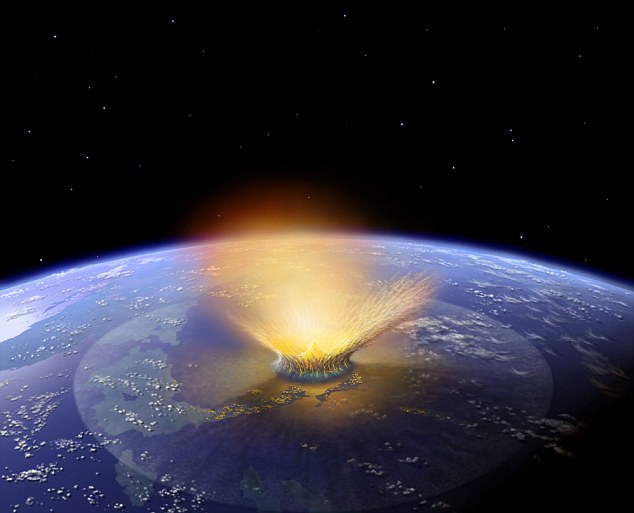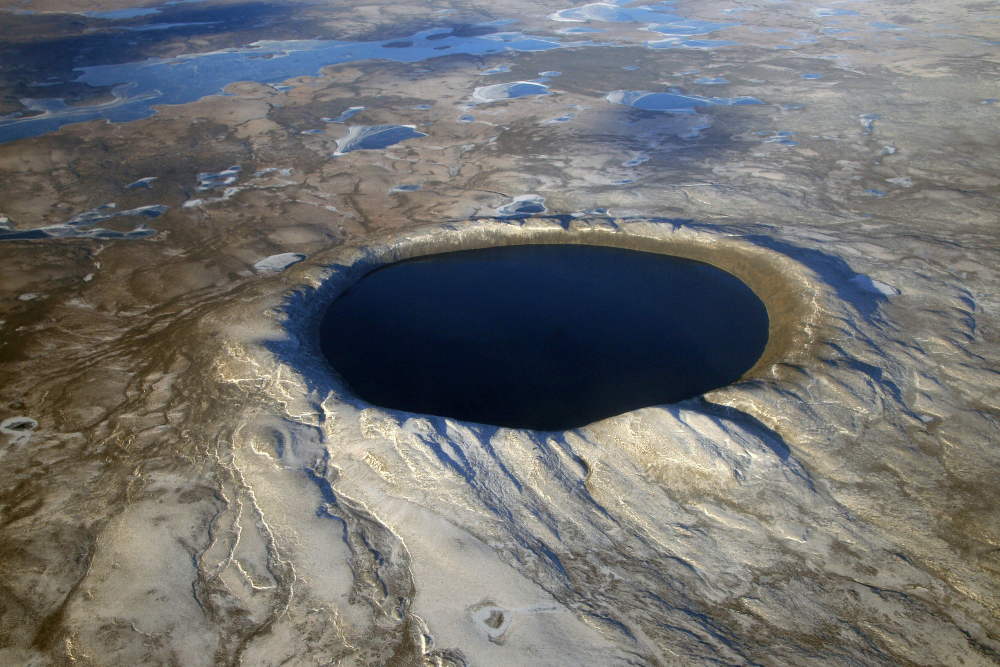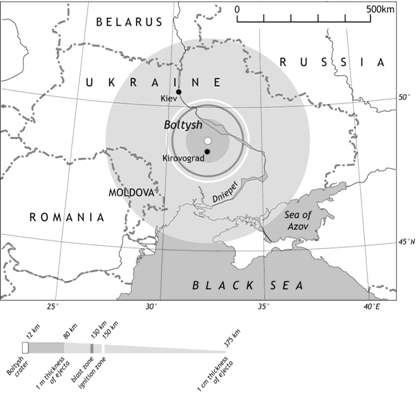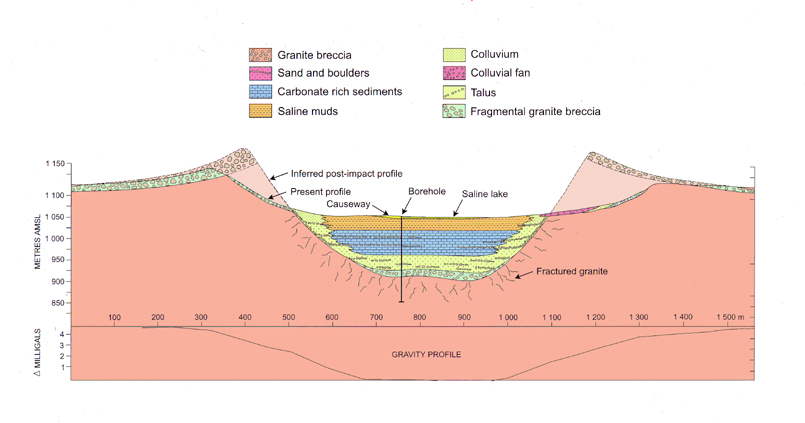Alien Life May Thrive in Impact Craters

An asteroid or comet smashing into the surface of a planet can spell doom for living creatures, but if the impact isn't large enough to completely decimate a planet's inhabitants, then the crater can ultimately provide a habitat for life. That's the finding of a new study reported at the European Planetary Science Congress in September by Iain Gilmour of the Open University in the United Kingdom.
If an ice- or water-rich area is the victim of an impact, the combination of heat and groundwater will create what is known as a hydrothermal system. In addition, many complex organic compounds, which could be precursor molecules for life, are created at high temperatures such as those generated by a collision. This combination could create the ingredients needed for life as we know it, making impact-induced habitats a potential candidate for the birthplace of life on Earth.
For a habitat within a crater to remain "home sweet home," there must be a constant supply of water and nutrients. The lifetime of the hydrothermal system is also crucial, as the heat from the impact will eventually fade away into its surroundings. [7 Theories on the Origin of Life]

Measuring the cooling time of an ancient crater can shed light on the importance of such an abode in the origins of life, and also probe how a crater can provide a habitable niche for microbial life on other planets.
Boltysh Crater in the Ukraine makes the perfect target for such an investigation, so Gilmour and his colleagues investigated the heating timescale of the crater.
The 15-mile-wide (24kilometers) crater was created around 65 million years ago, and predates the Chicxulub crater — the smoking gun from the asteroid impact that wiped out the dinosaurs — by a few thousand years. Shortly after the impact that formed Boltysh Crater, a lake formed within it, laying down layers of sediments over time.
In 2008, Gilmour and his team drilled a borehole 1,955 feet (596 meters) deep to sample these sediments, and found that the post-impact sedimentary record at this crater is well preserved, enabling the scientists to reconstruct the thermal history of the crater.
Breaking space news, the latest updates on rocket launches, skywatching events and more!
Taking the temperature of the crater
Different techniques can be used to persuade the sediments to reveal their past. One of the methods used by the scientists utilized molecules known as isomers, which have the same chemical formula but different structures.
Certain types of isomers are sensitive to heat, and the level of isomers will deplete at a certain rate when they are in the vicinity of a heat source. At the bottom of the Boltysh Crater core, which samples the layers of sediments laid down directly above the impact site, the levels of two different isomers drop significantly. The thermal degradation of the isomers can be measured experimentally, so it is known that the temperature of the lake was between 167 and 482 degrees Fahrenheit (75 to 250 degrees Celsius) for a time after the impact.
As the isomers are only depleted in a few meters of the core above the impact site, it is possible to place a limit on the heating duration. However, the isomers cannot reveal the source of the heat, which is why another experimental technique was used to characterize the post-impact heating.
This technique involved measuring the composition of certain isotopes within carbonates in the sediments. Isotopes of the same element have the same number of protons and electrons, but different numbers of neutrons. While different isotopes can undergo the same chemical reactions, the rate of reactions will be quicker for some isotopes. For instance, evaporation will deplete heavier isotopes while enriching lighter ones, leaving different levels of the isotopes.
Evaporation of a lake is strongly dependent on the amount of time that it takes for water to flow into and out of the lake, and this "flushing time" is recorded by the isotopes in the lake sediments. The flushing time will be altered by groundwater, heated from the impact, bubbling up through fissures into the lake. The isotope compositions of Boltysh Crater can thus be used to estimate the heating time by seeing how long the water in the lake interacted with the hydrothermal groundwater.

The sediments also contain minute traces of vegetation, and changes in the vegetation over time can be linked to changes in the environment. The flora at the bottom of the core reveal that vegetation had been recovering for a few thousand years after the Boltysh impact, until the Cretaceous–Paleogene impact decimated the vegetation, along with the dinosaurs. [Wipe Out: History's Most Mysterious Extinctions]
The sediments also record changes in carbon that coincide with a period of warming during the first few hundred thousand years of the early Paleogene. These events act as bookends, making it easier to date the sediments and thus the heating timescale of the lake.
The results show that the hydrothermal system at Boltysh persisted for somewhere between 30,000 and 40,000 years, and it seems that the presence of the lake significantly extended the heating time.
Haughton Crater in northern Canada, which is of a similar size to Boltysh, should have a comparable timescale for its hydrothermal system. However, Haughton crater did not fill up with a lake until millions of years after the impact, long after the hydrothermal system had cooled, and subsequently its heating timescale was only 5,000 years.
The formation of a lake and its longevity could be key factors in a crater being a home for life.
Craters as habitats in the solar system
"The cooling timescale, at 30,000 to 40,000 years, is not that long when one considers that after it's cold then it may not remain a viable habitat," said Gilmour. "The question then becomes one of cratering flux on early planets and whether that flux is enough to create interlinked habitats, but not so great as to potentially wipe out life."

Such a heating timescale suggests that in moderately sized craters, the heating may not have been significant enough to destroy all existing life, so microbial life might have survived.
Many craters on Mars are of a similar size, so there could still be a record of organic matter if the sediments that carry this information are preserved. This is part of the reason why NASA's Curiosity rover is currently rummaging around in Gale Crater on Mars searching for any signs of a past habitat.
A crater etched into the landscape of a planet is not only the fingerprint of the rogue solar system body that caused the collision; it also provides clues to the impact on life after such an event. Knowledge of the heating duration of Boltysh Crater, therefore, is a step forward in understanding how collisions influence life, both on Earth and on other planets.
This story was provided by Astrobiology Magazine, a web-based publication sponsored by the NASA astrobiology program.
Join our Space Forums to keep talking space on the latest missions, night sky and more! And if you have a news tip, correction or comment, let us know at: community@space.com.
Amanda Doyle is a freelance science writer who studied astrophysics at Keele University in the United Kingdom, earning a Ph.D. for her studies into the spectral analysis of solar-like stars. Her work as appeared in All About Space Magazine, BBC Sky At Night and Astronomy Now. She is a former editor of Popular Astronomy and has served as Deputy Transport Editor at Chemical Watch news & events by Enhesa.

